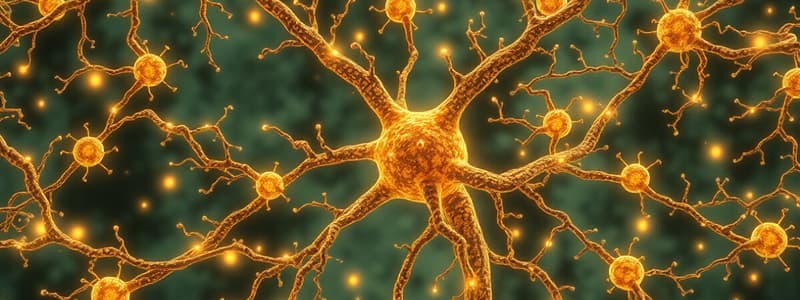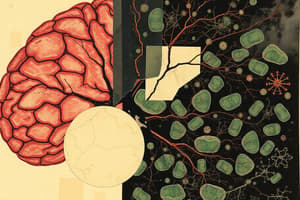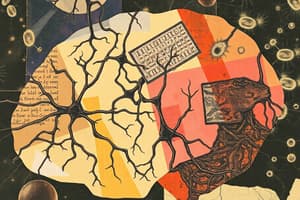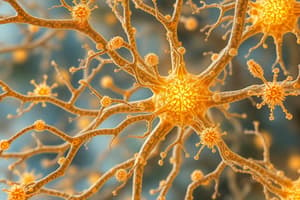Podcast
Questions and Answers
What is the role of neurotransmitters in the nervous system?
What is the role of neurotransmitters in the nervous system?
- They transmit signals chemically between cells. (correct)
- They increase the density of neurons in the synapse.
- They provide electrical signals directly between neurons.
- They are responsible for the regeneration of nerve cells.
Which statement best describes the organization of nervous tissue?
Which statement best describes the organization of nervous tissue?
- The organization varies by location to optimize function. (correct)
- Nervous tissue is solely responsible for muscle contraction.
- The arrangement of neurons and glial cells is constant regardless of function.
- Nervous tissue organization is uniform across the entire body.
What is the purpose of using staining techniques in histology for nervous tissue?
What is the purpose of using staining techniques in histology for nervous tissue?
- To visualize only motor neurons in the central nervous system.
- To increase the density of axons in neuronal samples.
- To differentiate neuronal structures and identify specific neuron types. (correct)
- To identify the genetic material within glial cells.
How does studying nervous tissue aid in understanding disorders of the nervous system?
How does studying nervous tissue aid in understanding disorders of the nervous system?
Which staining technique would be most appropriate for visualizing neuronal cell bodies?
Which staining technique would be most appropriate for visualizing neuronal cell bodies?
What are the primary functions of glial cells in nervous tissue?
What are the primary functions of glial cells in nervous tissue?
Which structure of a neuron is primarily responsible for receiving signals from other neurons?
Which structure of a neuron is primarily responsible for receiving signals from other neurons?
In which type of neuron is information primarily processed and integrated within the central nervous system?
In which type of neuron is information primarily processed and integrated within the central nervous system?
What characteristic feature do myelinated axons exhibit?
What characteristic feature do myelinated axons exhibit?
What role do microglia serve within the central nervous system?
What role do microglia serve within the central nervous system?
Which cell type is responsible for producing myelin sheaths in the central nervous system?
Which cell type is responsible for producing myelin sheaths in the central nervous system?
Which structural component of a neuron contains the nucleus?
Which structural component of a neuron contains the nucleus?
What is the primary function of synapses in the nervous system?
What is the primary function of synapses in the nervous system?
Flashcards
Neurotransmitters
Neurotransmitters
Chemicals that transmit signals between neurons at synapses.
Synapse Components
Synapse Components
Includes pre-synaptic and post-synaptic elements for neuron communication.
Nissl Stain
Nissl Stain
A special stain that identifies neuronal cell bodies in histology.
Nervous Tissue Organization
Nervous Tissue Organization
Signup and view all the flashcards
Importance of Histology
Importance of Histology
Signup and view all the flashcards
Nervous Tissue
Nervous Tissue
Signup and view all the flashcards
Neurons
Neurons
Signup and view all the flashcards
Glial Cells
Glial Cells
Signup and view all the flashcards
Neuron Structure
Neuron Structure
Signup and view all the flashcards
Myelin
Myelin
Signup and view all the flashcards
Sensory Neurons
Sensory Neurons
Signup and view all the flashcards
Motor Neurons
Motor Neurons
Signup and view all the flashcards
Synapses
Synapses
Signup and view all the flashcards
Study Notes
Nervous Tissue Overview
- Nervous tissue is specialized for communication. It is composed of neurons and glial cells.
- Neurons are the excitable cells responsible for transmitting electrical signals.
- Glial cells support and protect neurons, performing a variety of essential functions.
Neuronal Structure
- Neurons exhibit remarkable structural diversity for their roles in communication.
- Neurons consist of a cell body (soma), dendrites, and an axon.
- The cell body contains the nucleus and other organelles.
- Dendrites receive signals from other neurons.
- The axon transmits signals away from the cell body to other neurons or effector cells.
- Axons can be myelinated or unmyelinated. Myelin, a fatty substance, insulates the axon, increasing signal transmission speed.
Neuron Types
- Sensory neurons transmit signals from sensory receptors to the central nervous system.
- Motor neurons transmit signals from the central nervous system to muscles or glands.
- Interneurons connect neurons within the central nervous system, processing and integrating information.
Glial Cell Types
- Astrocytes are star-shaped cells supporting structure, regulating the chemical environment, and participating in nutrient exchange.
- Oligodendrocytes (CNS) and Schwann cells (PNS) produce myelin sheaths around axons, speeding nerve impulse conduction.
- Microglia are involved in immune defense, acting as macrophages within the central nervous system.
- Ependymal cells line the ventricles of the brain and central canal of the spinal cord, playing a role in cerebrospinal fluid production and circulation.
Histological Features of Nervous Tissue
- Nervous tissue displays a high density of cell bodies and processes.
- Tissue appears densely packed and complex.
- Myelinated axons exhibit a characteristic layered appearance.
- Differences in neuron and glial cell appearance aid microscopic identification.
- Neuroglia support nerve tissue and are prominent in preparations. The variation in glial cell shapes and their roles contribute to nervous tissue organization.
- Neuron types in different nervous system locations vary, significantly affecting appearance; for example, Purkinje cells are prominent in the cerebellum.
Synapses
- Synapses are specialized junctions between neurons or neurons and effector cells.
- They transmit signals chemically via neurotransmitters between cells.
- The synapse includes pre-synaptic (axon terminals) and post-synaptic components (dendrites/cell body).
- The interplay between pre- and post-synaptic structures facilitates neuron communication and coordinated responses.
Nervous Tissue in Different Locations
- Nervous tissue organization varies in the brain, spinal cord, and peripheral nerves throughout the body.
- Densities of neurons and glial cells adapt to specific functions.
- The arrangement of neurons and glial cells adjusts according to function and signal type.
Staining Techniques in Histology
- Special stains aid in distinguishing neuronal structures and identifying glial cells or specific neuron types.
- Nissl stain identifies neuronal cell bodies; myelin stains visualize myelin.
- These techniques provide insights into tissue organization, particularly nervous tissue, revealing diverse neuron types and structure.
Importance of Nervous Tissue Study
- Understanding nervous tissue is crucial for comprehending nervous system function and disorders.
- Histological studies assist in diagnosis and treatment strategy research.
- Histology provides detailed insights into the complexity and organization of nervous tissue.
- Identifying cellular arrangements and structures clarifies how nervous tissue facilitates communication and responses to stimuli.
Studying That Suits You
Use AI to generate personalized quizzes and flashcards to suit your learning preferences.




